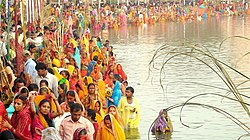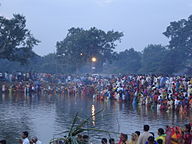Chhath: Difference between revisions
m Dating maintenance tags: {{Cn}} |
Prasann Gaurav (talk | contribs) →Rituals and traditions: Fixed typo, Fixed grammar Tags: Mobile edit Mobile app edit Android app edit |
||
| Line 63: | Line 63: | ||
==Rituals and traditions== |
==Rituals and traditions== |
||
The main worshipers, called ''Parvaitin'' (from Sanskrit ''parv'', meaning 'occasion' or 'festival'), are usually women. However, a large number of men also observe this festival as Chhath is not a gender-specific festival.<ref>{{cite web|url=http://timesofindia.indiatimes.com/city/patna/Men-not-far-behind-women-in-celebrating-Chhath/articleshow/55251895.cms|title=Men not far behind women in celebrating Chhath|deadurl=no|archiveurl=https://web.archive.org/web/20161111122821/http://timesofindia.indiatimes.com/city/patna/Men-not-far-behind-women-in-celebrating-Chhath/articleshow/55251895.cms|archivedate=11 November 2016|df=dmy-all}}</ref> The parvaitin pray for the well-being of their family, and for the prosperity of their offsprings. Once a family starts performing |
The main worshipers, called ''Parvaitin'' (from Sanskrit ''parv'', meaning 'occasion' or 'festival'), are usually women. However, a large number of men also observe this festival as Chhath is not a gender-specific festival.<ref>{{cite web|url=http://timesofindia.indiatimes.com/city/patna/Men-not-far-behind-women-in-celebrating-Chhath/articleshow/55251895.cms|title=Men not far behind women in celebrating Chhath|deadurl=no|archiveurl=https://web.archive.org/web/20161111122821/http://timesofindia.indiatimes.com/city/patna/Men-not-far-behind-women-in-celebrating-Chhath/articleshow/55251895.cms|archivedate=11 November 2016|df=dmy-all}}</ref> The parvaitin pray for the well-being of their family, and for the prosperity of their offsprings. Once a family member starts performing Chhath Puja, it is their compulsory duty to perform it every year and to pass it on to the following generations. The festival is skipped only if there happens to be a death in the family that year. If the person stops performing the ritual on any particular year, it stops permanently and one cannot resume it again. |
||
The prasad offerings include sweets, [[Kheer]], [[Thekua]], rice laddu(made of rice grit) and fruits (mainly sugarcane, sweet lime and banana) offered in small bamboo soop [[winnow]]s. The food is strictly vegetarian and is cooked without salt, onions or garlic. Emphasis is put on maintaining the purity of the food.<ref name=toi_thekua>{{cite news|title='Rasiao-kheer', 'thekua' make for festive platter|url=http://articles.timesofindia.indiatimes.com/2011-11-01/ludhiana/30345212_1_chhath-puja-ancient-hindu-festival-sun-god|accessdate=13 March 2012|newspaper=[[The Times of India]]|date=1 Nov 2011}}</ref> |
The prasad offerings include sweets, [[Kheer]], [[Thekua]], rice laddu(made of rice grit) and fruits (mainly sugarcane, sweet lime and banana) offered in small bamboo soop [[winnow]]s. The food is strictly vegetarian and is cooked without salt, onions or garlic. Emphasis is put on maintaining the purity of the food.<ref name=toi_thekua>{{cite news|title='Rasiao-kheer', 'thekua' make for festive platter|url=http://articles.timesofindia.indiatimes.com/2011-11-01/ludhiana/30345212_1_chhath-puja-ancient-hindu-festival-sun-god|accessdate=13 March 2012|newspaper=[[The Times of India]]|date=1 Nov 2011}}</ref> |
||
Revision as of 18:28, 20 October 2018
| Chhath Puja | |
|---|---|
 Performing of prayer to Sun around the holy rivers, ponds and other small water bodies | |
| Also called | Chhathi Chhath Parv Chhath Puja Dala Chhath Dala Puja Surya Shashthi |
| Observed by | |
| Liturgical color | Colors related to Hinduism Saffron (or Bhagwa) |
| Type | Cultural, Historical, Religious |
| Significance | To thank Sun for bestowing the bounties of life on earth and fulfilling particular wishes |
| Date | Kartik Shukla Shashthi |
| Part of a series on |
| Hinduism |
|---|
 |
Chhath is an ancient Hindu Vedic festival historically native to the Indian subcontinent, more specifically, the Indian states of Bihar, Jharkhand and Uttar Pradesh as well as the Madhesh region of Nepal.[1][2][3][4] The Chhath Puja is dedicated to the Sun and his wife Usha in order to thank them for bestowing the bounties of life on earth and to request the granting of certain wishes. Chhath does not involve any idol worship.[5] This festival is observed by Nepalese and Indian people, along with their diaspora.[6] While it is a Hindu festival, some Muslims also celebrate Chhath.[7]
The rituals of the festival are rigorous and are observed over a period of four days.[8] They include holy bathing, fasting and abstaining from drinking water (Vratta), standing in water for long periods of time, and offering prasad (prayer offerings) and arghya to the setting and rising sun.[9] Some devotees also perform a prostration march as they head for the river banks.[10]
Environmentalists claim that Chhath is the most eco-friendly Hindu festival.[11][12] Although the festival is observed most elaborately in Madhesh (southern) region of Nepal and Indian states of Bihar, Jharkhand and UP, it is also more prevalent in areas where migrants from those areas have a presence. It is celebrated in all Northern regions and major Northern urban centers in India. The festival is celebrated in the regions including but not exclusive to the northeast region of India, Madhya Pradesh, Bihar, Uttarkhand, Uttar Pradesh, Chhattisgarh, Jharkhand, Rajasthan[13][14] Bangalore,[15] Mauritius, Fiji, South Africa, Trinidad and Tobago, Guyana, Suriname, Jamaica, other parts of the Caribbean, United States, United Kingdom, Republic of Ireland, Australia, New Zealand, Malaysia, Macau, Japan, and Indonesia.
Date of the festival
Chhath puja is performed on Kartika Shukla Shashthi, which is the sixth day of the month of Kartika in the Vikram Samvat. This falls typically in the month of October or November in the Gregorian English Calendar. It is also celebrated in the month of Chaitra.
Chhath Puja 2018 Dates
Chhath puja is on the 13th(sunset) & 14th(sunrise) of November 2018. The four-day festival will start from 11 November and will end on 14 November.[citation needed]
It is also celebrated in the summer (March–April), on Chaitra Shashthi, some days after Holi; this event is called Chaiti Chhath.[16] Chhath is an arduous observance, requiring the worshipers to fast without sip of water for around 36 hours continuously.
Etymology
The word chhath means sixth [citation needed] in Nepali, Maithili and Bhojpuri languages and the festival is celebrated on the sixth day of the month Kārtika of the Hindu luni-solar Bikram Sambat calendar. The word is a Prakrit derivation from the Sanskrit ṣaṣṭhi, meaning sixth.It is the longest and most important festival after navratri.
The very first day of chhath starts exactly 4 days from Diwali and last for 4 more days. This day the people who observe fast take bath at a river or pond and prepare lunch (consisting of rice, dal mixed with pumpkin, made in pure ghee).
The second day (5th day from Diwali) is known as kharna or kheer- roti. In which the kheer( A Indian recipe where rice is prepared with sweetened milk instead of water) and chapati ( called roti in many Indian provinces). The people observe fast for the full day without taking even water and eat this kheer-roti as dinner after offering it to the rising moon and Goddess Ganga. This is the only time when they eat or drink anything from the starting of the day till the last day of chhath.
The third day is the main festival day (exactly 6th day from Diwali) of chhath.[17] The devotees maintain 'nirjal vrat(vrata)' ( Fast without even taking a drop of water ) on the third day. It mainly consist of going on river bank and offering 'argha' ( offering of fruits and sweets in winnow ) and surya namaskar to the setting sun followed by the next day (exactly 7th day from Diwali) event of offering argha and surya namaskar to the rising sun on the fourth or last day of chhath. The fast is then come to end after offering argha to rising sun. In this way, nearly 42 hours of strict penance comes to an end.
History
It is believed that the ritual of Chhath puja may even predate the ancient Vedas texts, as the Rigveda contains hymns worshiping the Sun god and describes similar rituals. The rituals also find reference in the Sanskrit epic poem Mahābhārata in which Draupadi is depicted as observing similar rites.
In the poem, Draupadi and the Pandavas, rulers of Indraprastha (modern Delhi), performed the Chhath ritual on the advice of noble sage Dhaumya. Through her worship of the Sun God, Draupadi was not only able to solve her immediate problems, but also helped the Pandavas later regain their lost kingdom.
Its yogic/scientific history dates back to the Vedic times. The rishis of yore used this method to remain without any external intake of food as they were able to obtain energy directly from the sun's rays. This was done through the Chhath method.[18]
Another history behind celebrating the Chhath puja is the story of Lord Rama. It is considered that Lord Rama of Ayodhya and Sita of Mithila had kept fast and offer puja to the Lord Sun in the month of Kartika in Shukla Paksh during their coronation after returning to the Ayodhya after 14 years of exile.[citation needed]
Chhathi Maiya
The Goddess who is worshipped during the famous Chhath Puja is known as Chhathi Maiya. Chhathi Maiya is known as Usha in the Vedas. She is believed to be the beloved younger wife of Surya, the sun god. In mithilanchal region she is also worshipped as name of "RANA MAI ".
This is the only parva which signifies rising sun as well as setting sun both.[citation needed]
The most unique feature about the Chhath Puja is the main idea behind it which is above the disputed concept of Murti Pujan (Idol Worshipping) unlike most of the festivals of the Hindu religion. Some people simply believe that, Sun is necessary for life of possibly every creature on the earth and this festival is a way to pay tribute to it irrespective of caste, creed, gender and social stigmas.
Rituals and traditions
The main worshipers, called Parvaitin (from Sanskrit parv, meaning 'occasion' or 'festival'), are usually women. However, a large number of men also observe this festival as Chhath is not a gender-specific festival.[19] The parvaitin pray for the well-being of their family, and for the prosperity of their offsprings. Once a family member starts performing Chhath Puja, it is their compulsory duty to perform it every year and to pass it on to the following generations. The festival is skipped only if there happens to be a death in the family that year. If the person stops performing the ritual on any particular year, it stops permanently and one cannot resume it again.
The prasad offerings include sweets, Kheer, Thekua, rice laddu(made of rice grit) and fruits (mainly sugarcane, sweet lime and banana) offered in small bamboo soop winnows. The food is strictly vegetarian and is cooked without salt, onions or garlic. Emphasis is put on maintaining the purity of the food.[20]
Gallery
- Chhath Puja
- Barari Ghat (Vikramshila Setu, Bhagalpur) Chhath Puja Morning Arghya at the banks of the Ganges
- Morning worship at Bokaro Steel City, Jharkhand
- View of a ghat in a village near Muzaffarpur, Bihar
- Chhath ghat at evening
- Diyanatpur
- Morning arghya (worship) of God Sun on fourth and final day of Chhat Puja celebrated at Hyderabad
References
- ^ "Chhath festival celebrated in India and Nepal begins today : The Indian Express". Archived from the original on 5 November 2016.
{{cite web}}: Unknown parameter|deadurl=ignored (|url-status=suggested) (help) - ^ "Chhath natively celebrated in India and Nepal has significance in Hindu Culture". Archived from the original on 5 November 2016.
{{cite web}}: Unknown parameter|deadurl=ignored (|url-status=suggested) (help) - ^ Subhamoy Das. "Chhath Puja". About Religion. Archived from the original on 17 November 2015. Retrieved 16 November 2015.
{{cite web}}: Unknown parameter|deadurl=ignored (|url-status=suggested) (help) - ^ "Festivals of India And Nepal - CHHATH FESTIVAL". Archived from the original on 7 June 2009.
{{cite web}}: Unknown parameter|deadurl=ignored (|url-status=suggested) (help) - ^ "A festival not confined to Bihar". Archived from the original on 23 December 2017.
{{cite web}}: Unknown parameter|deadurl=ignored (|url-status=suggested) (help) - ^ "No Nepalese and Bihari diasporas want to stay out of home in Chhath :: Patna Reportings". Archived from the original on 18 September 2014.
{{cite web}}: Unknown parameter|deadurl=ignored (|url-status=suggested) (help) - ^ "Some Muslims too celebrate Chhath in Bihar". Archived from the original on 26 October 2017.
{{cite web}}: Unknown parameter|deadurl=ignored (|url-status=suggested) (help) - ^ "Chhath at the crossroads". Archived from the original on 6 November 2016.
{{cite web}}: Unknown parameter|deadurl=ignored (|url-status=suggested) (help) - ^ "Chhath rituals bring family together". Archived from the original on 24 October 2017.
{{cite web}}: Unknown parameter|deadurl=ignored (|url-status=suggested) (help) - ^ Sah, Jitendra (8 November 2016). "Sun worshippers". The Kathmandu Post. Archived from the original on 11 November 2016. Retrieved 11 November 2016.
Some devotees go to river banks to worship the sun by prostrating themselves the entire distance.
{{cite news}}: Unknown parameter|deadurl=ignored (|url-status=suggested) (help) - ^ "Chhath the most eco-friendly festival: Environmentalists". Archived from the original on 11 November 2016.
{{cite web}}: Unknown parameter|deadurl=ignored (|url-status=suggested) (help) - ^ "Ode to god of green things". Archived from the original on 1 August 2017.
{{cite web}}: Unknown parameter|deadurl=ignored (|url-status=suggested) (help) - ^ "Surat 1 lakh to celebrate chhath puja". Jai Bihar. 22 October 2009. Archived from the original on 3 January 2010. Retrieved 14 December 2009.
{{cite news}}: Unknown parameter|deadurl=ignored (|url-status=suggested) (help) - ^ "15 lakh to observe Chhath Puja in Delhi". Jai Bihar. 22 October 2009. Archived from the original on 2 November 2009. Retrieved 14 December 2009.
{{cite news}}: Unknown parameter|deadurl=ignored (|url-status=suggested) (help) - ^ "Juhu Beach decks up for worshiping the sun god". DNA India. 24 October 2009. Archived from the original on 28 February 2012. Retrieved 14 December 2009.
{{cite news}}: Unknown parameter|deadurl=ignored (|url-status=suggested) (help) - ^ "Chaiti Chhath to start today". Jai Bihar. 30 March 2009. Archived from the original on 4 January 2010. Retrieved 14 December 2009.
{{cite news}}: Unknown parameter|deadurl=ignored (|url-status=suggested) (help) - ^ "Chhat Puja, the biggest festival in Bihar that falls on the sixth day after Diwali". Archived from the original on 22 December 2017.
{{cite web}}: Unknown parameter|deadurl=ignored (|url-status=suggested) (help) - ^ Sri Chhath Mahaviggyaan (The Science of Chhath) by Yogishri Oumkaar
- ^ "Men not far behind women in celebrating Chhath". Archived from the original on 11 November 2016.
{{cite web}}: Unknown parameter|deadurl=ignored (|url-status=suggested) (help) - ^ "'Rasiao-kheer', 'thekua' make for festive platter". The Times of India. 1 November 2011. Retrieved 13 March 2012.










